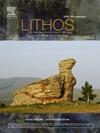杨拉矿床三叠纪-渐新世叠加W矿化:来自白钨矿地球化学和U-Pb年代学的证据
IF 2.5
2区 地球科学
Q2 GEOCHEMISTRY & GEOPHYSICS
引用次数: 0
摘要
中国西南三江地区位于特提斯东部成矿带内,拥有与三叠纪花岗类相关的大型矽卡岩体系杨拉铜矿床。综合矿物组合、U-Pb年代学和白钨矿微量元素组成,确定了杨拉两个离散的钨成矿事件。(1) s组白钨矿与黄铜矿、黄铁矿同期赋存于夕卡岩矿石中,与三叠纪夕卡岩铜成矿有关。地球化学特征为Nb + Ta含量高,Sr/Mo比值低,Eu负异常明显,与花岗岩相关W矿床的白钨矿相一致。(2) B-组白钨矿和m -组白钨矿分别赋存于热液角砾岩和大理岩矿石中,形成于渐新世(m -组白钨矿U-Pb年龄28.1 ~ 30.0 Ma),与辉锑矿和方解石形成于同一时期。它们具有明显的地球化学特征,包括低Nb + Ta含量、高Sr/Mo比和略正的Eu异常,支持非岩浆流体成因。将杨拉三叠纪岩体与三江地区其他W多金属、Cu和W相关花岗岩进行对比,发现其岩浆来源和分选程度与与W多金属矿床相关的花岗岩具有明显的相似性。这些花岗岩具有壳幔混合源和中~高岩浆分馏作用,可能是钨多金属矿床形成的关键控制因素。三叠系矽卡岩白钨矿的发现挑战了杨拉仅为新生代钨矿的传统观点,为区域隐伏钨矿的找矿策略提供了重要见解。本文章由计算机程序翻译,如有差异,请以英文原文为准。
Superimposed Triassic and Oligocene W mineralization in the Yangla deposit, Southwest China: Evidence from scheelite geochemistry and U-Pb geochronology
The Sanjiang region in southwestern China, located within the eastern Tethyan metallogenic domain, hosts the Yangla Cu deposit, a large-scale skarn system associated with Triassic granitoids. This study integrates mineral assemblages, U-Pb geochronology, and trace element compositions of scheelite to identify two discrete W mineralization events at Yangla. Three scheelite groups have been identified: (1) S-group scheelite, hosted in skarn ores, is coeval with chalcopyrite and pyrite, indicating its association with Triassic skarn Cu mineralization. Geochemically, it exhibits high Nb + Ta contents, low Sr/Mo ratios, and pronounced negative Eu anomalies, consistent with scheelite from granite-related W deposits. (2) B- and M-group scheelite, hosted in hydrothermal breccia and marble ores, respectively, formed during the Oligocene (M-group scheelite U-Pb ages: 28.1–30.0 Ma) and coeval with stibnite and calcite. They display distinct geochemical signatures, including low Nb + Ta contents, high Sr/Mo ratios, and slightly positive Eu anomalies, supporting a non-magmatic fluid origin. A comparison of the Yangla Triassic intrusions with other W polymetallic, Cu- and W-related granites in the Sanjiang region reveals significant similarities in both magmatic source and fractionation degree to those of granites associated with W polymetallic deposits. These granites exhibit mixed crust-mantle source and moderate to high degree of magmatic fractionation, which may be a critical control on the formation of W polymetallic deposits. The identification of Triassic skarn scheelite challenges the traditional view of Yangla as a solely Cenozoic W deposit, providing critical insights for regional exploration strategies targeting concealed W orebodies.
求助全文
通过发布文献求助,成功后即可免费获取论文全文。
去求助
来源期刊

Lithos
地学-地球化学与地球物理
CiteScore
6.80
自引率
11.40%
发文量
286
审稿时长
3.5 months
期刊介绍:
Lithos publishes original research papers on the petrology, geochemistry and petrogenesis of igneous and metamorphic rocks. Papers on mineralogy/mineral physics related to petrology and petrogenetic problems are also welcomed.
 求助内容:
求助内容: 应助结果提醒方式:
应助结果提醒方式:


